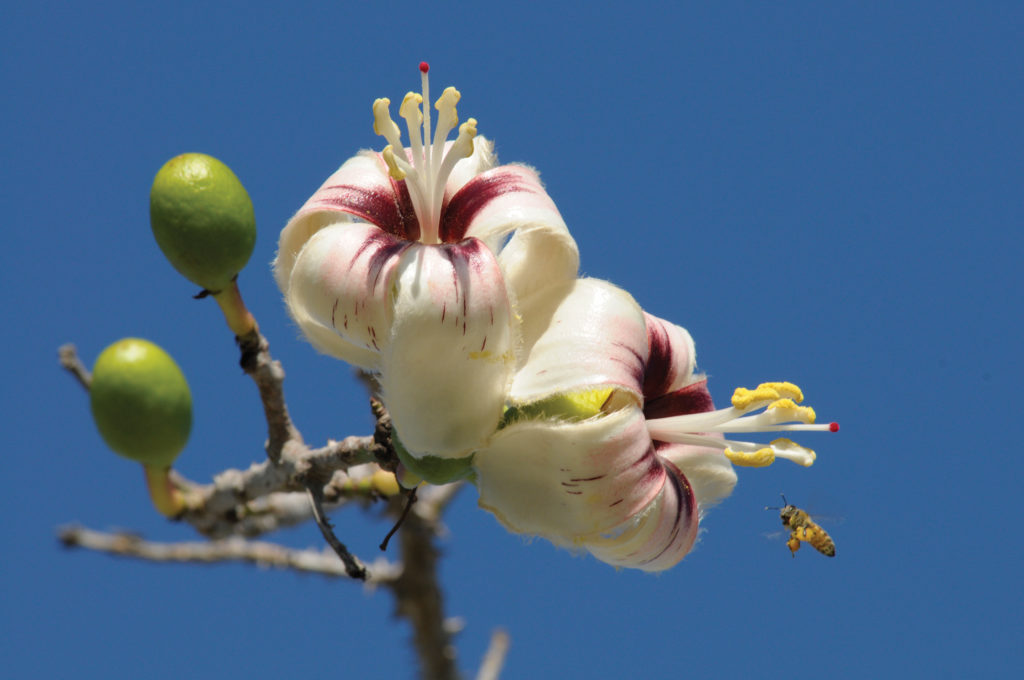It had been known as “The Dancing Tree,” and for years it had greeted Naples Botanical Garden guests as they descended the gentle slope from the plaza honoring legendary Brazilian landscape designer Roberto Burle Marx.
The tree, in the Ceiba genus of South American origin, sprouts thorns on its bark, spiky and thumb-tack sharp. Barbs aside, this tree’s branches were willowy and bore white, lily-shaped blossoms with mulberry-colored streaks, giving it an entirely friendly effect—a favorite of staff and guests. It had been grown from a seed Burle Marx had gifted his protégé, Raymond Jungles of Miami, who in turn had given it to Naples Botanical Garden when he designed its Brazil Garden. In the tree, Jungles saw a “sculpture in motion,” and named it accordingly.
Hurricane Irma roared through the garden last Sept. 10, shredding foliage, decapitating palms, ripping limbs—and felling the lovely wooden dancer.
“Heartbreaking,” CEO and President Donna McGinnis said a few days later—of favorites lost, of the entirety of the mess.
All told, winds uprooted or severely damaged some 500 trees. Staff and volunteer horticulturalists from around the country saved about 200 of them. Even so, the wood from unsalvageable trees and other plant matter amounted to nearly 4 acres worth of debris. A third of the canopy was gone; sunlight scorched the ground plants, seared walkways, intensified cleanup.
But Naples’ love for its garden runs deep. Staff, community volunteers and guest horticulturalists labored incessantly. Three weeks to the day after Irma’s landfall, the garden flung open its gates. For that Oct. 1 reopening, staff members arranged colorful snippets of uprooted flowers and greenery in a giant mandala—the horticultural equivalent of shaking a fist and vowing resilience.
McGinnis and her team faced years of regrowth and replanting. But they decided against merely replicating the pre-hurricane garden. Rather than curse Irma for taking The Dancing Tree and other botanical heirlooms, they would instead regard her as a catalyst for expediting existing plans and initiating new ones. In the year that followed, the staff began taking the garden into its next era, one marked by a targeted focus on conservation, biodiversity and broadening the role that Naples plays in the larger botanical world.
“The garden won’t ever look exactly the same as it did before the hurricane,” McGinnis wrote in a blog posting shortly after the storm. “It will be different, but just as spectacular.”
Hot, dead air settled upon Southwest Florida in the storm’s aftermath, prolonging summer and post-storm stress. By late October, though, anxieties quelled, breezes cooled, and mornings turned perfect for garden strolling. Which is what I am doing on a quiet Friday with Chad Washburn, the vice president of conservation. I do not know the garden well, having visited just once before the storm, and Washburn indulges my many before- and after-themed questions.
We pause in Brazil, the most seriously damaged garden.
“Is it beautiful? Yes,” he says of a newly replanted patch on Brazil’s fringe. But by botanical garden standards, the bed is unremarkable, he says. There are rows of begonias—a nice-enough plant but rather run-of-the-mill in Southwest Florida. The area we’re examining used to house more than 30 different species; the begonias are merely placeholders until Washburn and other key leaders including Vice President of Horticulture Brian Galligan can acquire something, or multiple “somethings,” more spectacular.
Plant selection is where the botanical garden’s great opportunity lies.
Earlier, Washburn had explained the role botanical gardens play—aside from offering a serene spot for morning strolls—and outlined the leadership team’s aspirations for deepening the garden’s mission.
“A garden is very much a museum of plants,” he says. And just like a museum, it wants to house spectacular, eye-catching flora. In industry lingo, they are known as “charismatic plants”—things with spikes or cones or intricately patterned shapes, awe-inspiring color or stop-you-in-your-tracks fragrances. The Dancing Tree had been a good example.
But the display is only one part of the mission. The others are conservation, research and education.
Washburn pulls out a spreadsheet that tallies specimens endemic to Caribbean and Latin American countries and highlights the species not protected in any botanical garden. Mexico alone has 438 such trees, Cuba, 299. As he looks for new plants, he’ll target the most vulnerable of species from here and abroad.
A botanical garden, Washburn notes, is a little bit like the Biblical ark—a safeguard against extinction on a planet that increasingly unleashes hurricanes and floods, wildfires and volcanic eruptions.
Conservation had always been part of Naples’ mission, but the windy purge offered the opportunity to reposition that goal from the periphery to the center.
“The hurricane was a gentle reminder that conservation is important,” Washburn says. “Those kinds of events are a wake-up call. We really need to be out and leading the conservation efforts.”
Over the coming months, he and Galligan and McGinnis and other senior staff would court botanical garden administrators from Cuba, Puerto Rico, California and other climatic cousins, laying the groundwork for the exchange of plant material, resources and ideas. They wanted, in particular, plants with known “provenance,” or data on their history and places of origin. Plants are like art—the better you can trace their lineage, the more valuable they become.
The seeds of Naples Botanical Garden began germinating back in 1993—25 years ago—with a small group of Naples residents who longed for a horticultural showpiece.
The initial concept was humble. “I thought it would be a little garden across the street from Windstar,” says Linda White, one of those founding residents, referring to a 30-acre parcel on Bayshore Drive, opposite the Windstar golf community where she lives for most of the year.
Knowing the garden’s organizers needed more clout—and dollars—behind them, White “cold-called” one of Naples’ leading philanthropists, Harvey Kapnick. Kapnick was unwell at the time, but to White’s great surprise, he returned her call some months later. He toured the land, declared it unsuitably small, and wrote a fat check to bolster acquisition efforts.
Meanwhile, Collier Enterprises owned 68 acres nearby for a proposed new development—one vehemently opposed by Port Royal residents. The developer ultimately gave up. Armed with Kapnick’s donation, the botanical garden founders purchased the Collier land. In addition, they tracked down absentee landlords along Bayshore Drive and persuaded them to sell, amassing another 102 acres.
The land was a mess of melaleuca, Brazilian pepper and similar undesirables. The community was invited in to clear it out. “We went through the land and saved all the things that could be saved,” remembers longtime volunteer Betty Plum. It’s no wonder that, after Irma, residents full- and part-time alike inundated McGinnis with queries or rushed there to help or sent in $1.2 million worth of donations. The place from its inception was a labor of community love.
Neapolitans may love homegrown, but they don’t necessarily relish the appearance of “homespun.”
They lured one Brian Holley, the charismatic leader of Cleveland Botanical Garden, to transfer his talents here in 2005. Holley, in turn, assembled what the Miami Herald dubbed the “dream team,” a group of renowned landscape architects, including Jungles, to imagine a botanical garden like no other.
The garden would celebrate communities and cultures that, like Naples, fall along the 26th latitude. Those include Brazil, Southeast Asia and the Caribbean. Holley chuckles about his initial disdain for the board’s concept: “Honestly, I thought it was more of a marketing thing than a mission, but as we progressed … it just emerged as a no-brainer. … It was brilliant. It really has been an organizing element. It gives you focus.”
The plumeria hills are not the most beautiful part of Naples Botanical Garden. In fact, you might find them downright off-putting, especially when the trees—spindly and sticklike—are not in bloom.
But this is one of the most important areas of the garden, as it houses The National Plumeria Collection, an amalgamation of more than 500 species and cultivars of the flowering tree. That’s what draws Dr. Stephen Brady back there, to try to figure out what to do with it.
Technically, Brady is not on staff, but it’d be hard to imagine Naples Botanical Garden without him. He’s a former internist who in retirement dedicates himself fully to his lifelong love of botany. He was featured in the 2012 documentary The Fruit Hunters and is recognized internationally for his expertise.
In recent months, Brady has been drafting lists of charismatic trees and plants to guide rebuilding efforts. “As I started to see what happened here and the amount of rebuilding we have to do, it started to occur to me that we needed to do this in a really carefully thought-out, planned fashion,” he says. “The heart of the collection are the charismatic plants. Those are the plants that reach out and grab you by the soul.”
Brady’s hands are in lots of other decisions—from selecting new varieties of mangos to replace the wind-felled ones to growing replacement plants on his nearby 2-acre property. Later, he would be a guiding force behind the senior staff’s trip to California, which would yield hundreds of new plants. The globetrotting collector would email the administrators with scavenger hunt-like instructions on what to look for: “At such and such garden, on the northwest corner of such and such building, there’s a tree that should have fruits on it that you need to look for,” is how Washburn describes the memos.
On this particular spring morning, Brady is explaining the decisions that must be made on the plumeria. Irma had uprooted every single tree, Brady says, revealing a gardening flaw—the roots had remained bound in the shape of the pots in which they had sprouted. If the garden must be replanted, the staff agreed, they might as well re-examine their gardening standards. The administration is investing in new forestry pots for many of its young plants—more pricey than standard nursery containers but guaranteed to produce a better root system.
There has been an ongoing conversation, Brady says, about how to make the plumeria collection more visible and visitor-friendly and how to create a rating system so that the least interesting of the trees might be culled. (The ones registered with the Plumeria Society of America will stay.) “Here’s one I would call a not-very-exciting yellow. That one has a nice, intense color, but I would be looking to replace that with one of the big cerise-colored ones.”
“It’s all curation,” Brady explains. “Now that we are confronted with a damaged garden, we have to decide what to keep and what not to keep. It’s a very important set of decisions. Everybody is thinking about it.”
There are knee-high pantyhose dangling off branches of some trees. The storm and uprooting stressed the trees and interfered with their seed production. “I just want the seeds to not blow away,” Brady explains of the makeshift protective covering. Administrators had recently struck a deal with a garden in Brazil to house a duplicate collection there—a safeguard for the next time 140-mile-an-hour winds decide to tear through Naples.
Chainsaws buzz one early February morning. Brian Galligan, the vice president of horticulture, greets a crew of four from Morton Botanical Garden in Chicago, which is renowned for its trees. They’re doing “corrective pruning,” trimming and reshaping trees that had become lopsided or otherwise damaged in the storm. The Morton arborists are among the many out-of-town horticultural crews that have offered assistance in the year following Irma.
“Those trees were last pruned by me when they were lying on the ground. I told them not to judge me too much,” Galligan says, grinning, watching the arborists at work.
Much of the year following Irma is spent on deepening relationships with other gardens. Galligan, Washburn and other members of their teams visit Cuba twice and host garden administrators from the island. They travel to Puerto Rico to aid a botanical garden’s post-Maria clean up, as so many others had done for them. They tour California gardens. They continue conversations with Haiti’s Botanical Garden of Les Cayes, which Naples had assisted following Hurricane Matthew in 2016.
New opportunities bloom as a result. With Puerto Rico, for example, the Naples staff is pursuing a memorandum of understanding to protect threatened plants and replicate each other’s collections. “We share more plant material with Puerto Rico than we do with Tampa,” says Galligan, explaining the climate commonalities between Southwest Florida and the island.
They see new potential for shared research, such as studies of “crop wild relatives,” plants that are closely related to domesticated ones. The garden’s staff already had been working to collect swamp bay seeds from throughout Collier County and examine these avocado relatives for signs of resistance against the laurel wilt fungal disease that is threatening the Florida and California industries. Hybridize wild and domestic plants, and farmers may stand a chance against crop-destroying pests. “Botanical gardens are probably the best-positioned (institutions) in the world to be able to collect and save crop wild relatives,” Washburn says.
There was talk of Naples, which is young by botanical garden standards, becoming a meeting and training site—a place where botanical gardens from northern and southern hemispheres might come together, McGinnis says. “We are becoming a much bigger player in the (botanical) world—much faster than we would have gotten there without Irma’s help,” she says.
The relationships yield unexpected surprises.
On a cool, dewy mid-December morning, a four-person team from Pennsylvania’s Longwood Garden hauls debris and installs new plants for the children’s garden, one of several projects they tackle during their weeklong stay.
They’d heard about the loss of The Dancing Tree and they offer a gift: Clippings from a tree of the same species growing in their conservatory—installed by none other than Roberto Burle Marx himself. A Naples staff member would retrieve them during her visit over the summer.
The packages arrive on a Tuesday in early June. Nine of them—white Federal Express boxes laid out on a 6-foot folding table and placed outside an administrative building. The delivery is such a big deal that McGinnis calls a staff meeting, and at 1 p.m. employees gather under a shady trellis.
“This is getting real now,” one gardener murmurs to another. Washburn ceremoniously reaches into the first box. Packed into it are dozens upon dozens of plants—clippings from trees and shrubs, leaves and seeds. “I don’t even know how many these contain,” he says, with Christmas morning-like wonderment.
The plants had come from California following the senior staff members’ participation in an American Public Gardens Association conference and an ensuing tour of nurseries and botanical gardens. They’d amassed a collection of diverse and unusual plants that would fit well in existing gardens or perhaps populate a new one in the future.
“OK, everybody, come have a look,” McGinnis invites. They edge closer. Washburn holds up various specimens. “I have never seen anything like this one,” he says of a ground-covering plant. Then, of another species, “This doesn’t look like much, but it produces beautiful, bell-shaped flowers.”
“That’s beautiful,” coos one staff member to her straw-hatted colleague.
“This is the future of the gardens,” Washburn says.
“Look, these are sprouting already,” Nick Ewy, the associate director of horticulture, says about a week after the FedEx delivery, peering at tender green shoots emerging from a pot in the greenhouse. Andrea Grace, the nursery manager, over the past week had worked feverishly to plant and root and store the California collection.
“It’s so neat to see all the diversity,” Grace adds. On a table in front of her are some 50 specimens of epiphyllum, flowering cacti, that had come back from California. These leaf clippings will sprout roots and yield an entire array of new plant life for Neapolitans to enjoy.
Nearly every square foot of the nursery is crowded with pots. High on the to-do list is expanding and updating the growing facilities; a new fog house installed just outside of the nursery had been the first step.
Back in the hard-hit Brazil Garden that morning, Danny Cox, the aquatic plants manager, shows me a cluster of new water lilies that would root in time for their blooming season in August. His focus in these last months had been on storm repair and recovery, and he relishes the opportunity to begin beautifying the ponds and pools once more. The garden, in fact, has been tapped to host an international water lily competition in 2019, bringing in new hybrids from all over the world.
A few paces away, Ewy and Liz Chehayl, the garden’s curator, point out the still-lingering signs of Irma—there’s orange tape on one tree and a support belt encircling another. A cluster of palms rustles in a light wind; the fronds look healthy thanks to Ewy’s post-storm pruning and untangling, but it could be a year or more before the staff knows which apparent survivors are internally damaged and won’t make it in the long run.
Donors had contributed $1 million toward recovery efforts; another $600,000 or so was needed to offset the losses, McGinnis says in mid-summer. She’d submitted a FEMA request, but was still waiting to hear what she might recoup.
Ewy shows me a flowering plant that he plans to install in one of the beds. The erythrina amazonica is a tricky one to grow, due to the pests that like to nibble the buds, but Ewy has nurtured this one from seed, succeeded in getting it to bloom, and hopes it will do so again in the Brazil Garden. “The flower that came out of it was gigantic,” he says, spreading his hands about a foot apart. “It was absolutely amazing.”
We pause by the site where The Dancing Tree had stood. A new tree is in its place, a coussapoa, a Brazil native that sprouts aerial roots, like a ficus. In California, Ewy had inadvertently bumped into its parent tree growing in a conservatory at The Huntington in San Marino. “I looked over and thought, ‘That looks familiar!’” There are only three such trees growing in U.S. botanical gardens—at Huntington, in Naples and at the Montgomery Botanical Center in Coral Gables (which had gotten its tree from a Huntington clipping, too).
In California, the coussapoa was relegated to a pot, needing the warmth of the conservatory to survive. But this one, in subtropical Naples, well, it could grow into a “monster,” Ewy says. A charismatic tree if ever there were one.
What’s that McGinnis had promised in the storm’s wake? A different garden—but a spectacular garden still.
On a mid-July evening, she reflects on the year’s journey.
“While it was really difficult to get through at the beginning, (the hurricane) has opened up so many doors for us,” she says, thinking about the developing partnerships, the conservation thrust, the push for better growing facilities, advancing growing standards, the potential for research. “As tough as it’s been, the silver lining has been amazing.”





